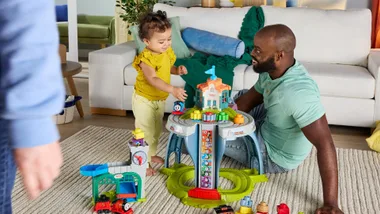Making the switch from a smaller car that’s been by your side for years to a family vehicle that will accommodate your growing brood can be daunting. What should you be looking for? How much will it cost? Does it have to be a station wagon?!
The truth is, buying a new car that’s fit for road trips, school runs, scooters and, lets’ face it, a tantrum or two, is no mean feat. But, doing your research beforehand will save you time, money and stress so here are our top tips for shopping for your first family car.
1. Safety first
It goes without saying that safety should be the top priority list when buying a family car. As excellent as your driving no doubt is, it’s a terrifying truth that accidents do happen, so you want your car to be equipped with the best safety features that money can buy.
Most modern cars come with ABS brakes, air bags and electronic stability control as standard these days, but you can also opt for reversing sensors for extra peace of mind. It always pays to be extra cautious and check your prospective car’s ‘safety rating’ at Ancap.
2. Comfort is key
Day trips can quickly turn sour – for kids and big kids alike – when you’re stuck in a stuffy car for hours on end. Don’t make it worse by throwing uncomfortable seating into the mix. When shopping for a car, look for comfortable seats, good back support and neck rests and plenty of leg room. Given the likelihood of stinking hot summer days, it’s always worth opting for air conditioning, too; even if you have to pay extra – trust us!
3. Choose practicality over pretty
Looks may have been the key factor in selecting a car in the past, but ultimately they mean nothing to a toddler – unless you dress your car up as Peppa Pig! That’s not to say you have to completely sacrifice on style – car manufacturers quickly cottoned on to the fact that sleek sedans and stylish SUVs would go down well with first-time families – it just might mean parking (sorry) your two-seater dreams in favour of space, reliability and comfort for now.
If you envision lots of family camping trips coming up, it’s worth researching to find out which of your options fare best in terms of longevity. Heads up: the Honda Accord and Toyota Camry are two of the best options to get to 200,000 miles and beyond according to Consumer Reports. Seven-seater cars are also a practical option with their flexible seating; that way you won’t have to be in this position every time your family grows.
4. Shop around for financing
You shouldn’t have to forego your dream car for fear of not being able to afford it, which is where car financing comes in. If you don’t know where to start – and are feeling overwhelmed by all of the “best deals” out there – get professional advice. Online comparison tools such as Savvy Car Loans are a great resource for families who don’t have the time to make a gazillion phone calls. They’ll compare your options from all of the major banks and lenders in the county to find you the best deal. Best of all, you’re not locked into anything just because you talk to them – it’s obligation-free. Bonus!
5. Consider running costs
A ‘bargain’ upfront price isn’t really a bargain if you’ll end up spending heaps on general upkeep over the years. Aside from the obvious environmental impact of ‘gas guzzlers’, cars that aren’t fuel efficient will also dent your pockets in the long run. Check out the government’s Green Vehicle Guide before buying to find out how your prospective new buy stands up in terms of fuel efficiency.
6. Will you be spending more on insurance?
Yes, most likely. But, you can keep insurance costs down by using a car insurance comparison online tool, seeking discounts via multi-policies and taking advantage of discounts offered for paying in full rather than in monthly installments. Also, be mindful of going OTT on the engine size. Yes, you’ll need a bigger engine to carry more people, but don’t go bigger than you really need or pay for it in insurance premiums.
7. Size does matter
Especially when it comes to boot space! You might not have given much weight to the size of a car boot before, but it’s about to become the holy grail of your world. Keep in mind that some smaller cars have deceptively large interiors and plenty of boot space so it pays to look inside them all and keep judgement until the end.
8. You’ll save by going second-hand
Let’s face it, little ones are expensive. So if you’re upgrading your car out of necessity only and feeling the financial strain, consider a second-hand model. A new car loses value as soon as it leaves the showroom so it can be a no-brainer for those on a budget. If you’re worried about the reliability of a pre-owned car, buy from a dealer and try to get a warranty included in the sale to give you peace of mind.
Brought to you by Savvy











